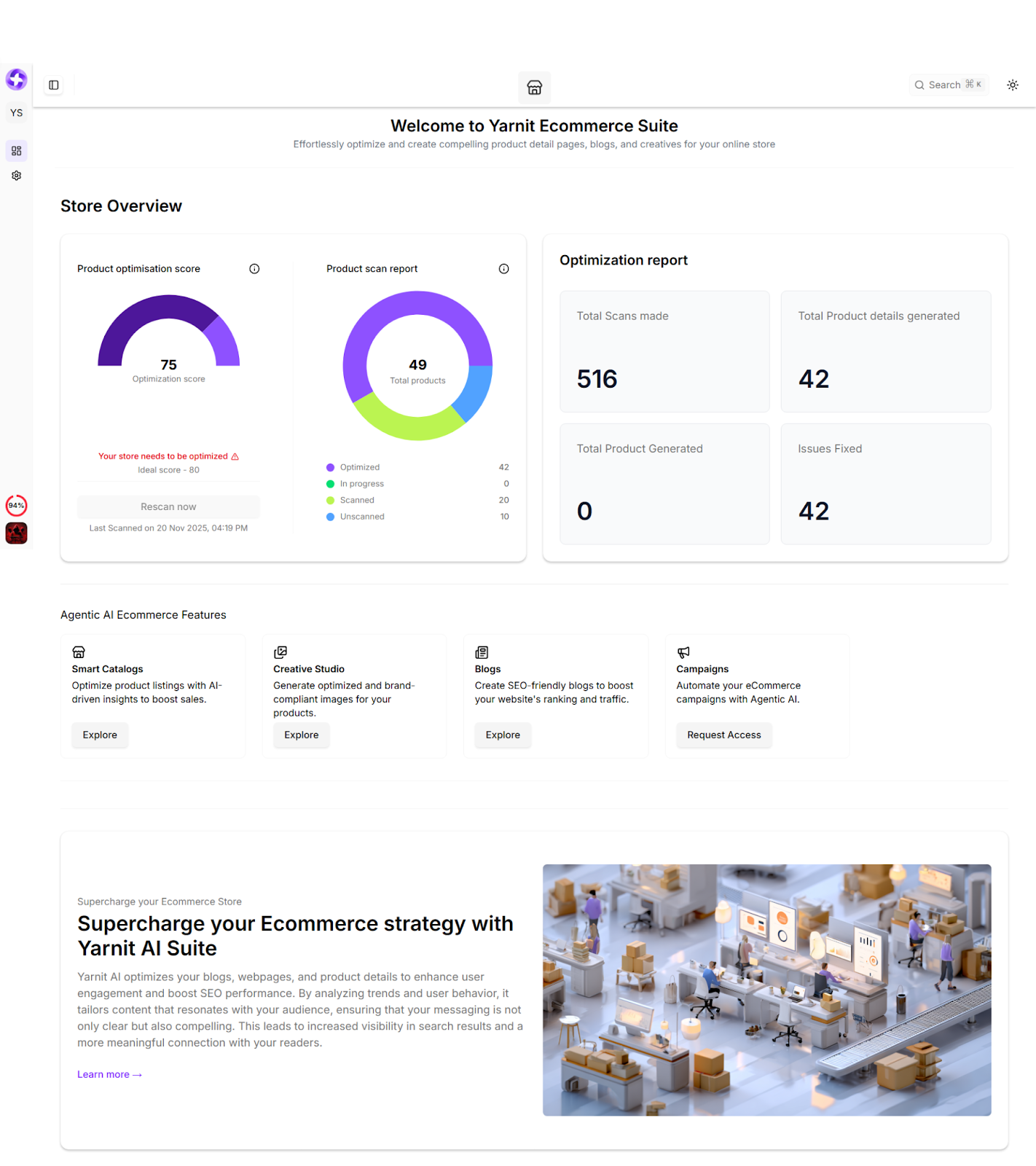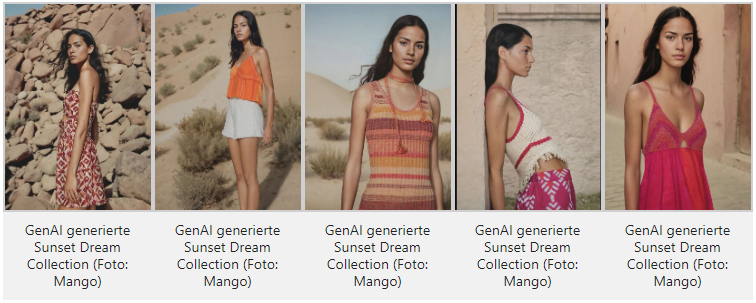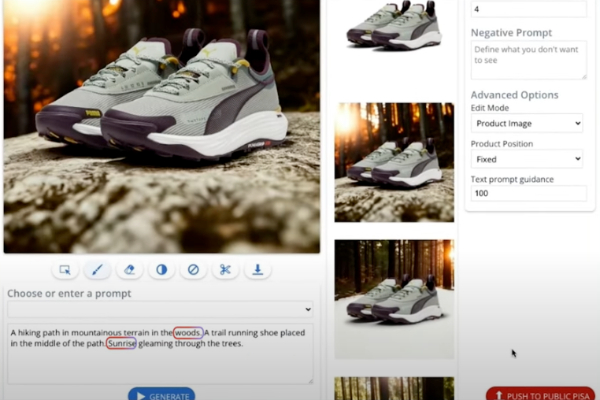Take a look at this checklist. If you're running a fashion ecommerce brand and most of these apply to you, you're ahead of the curve heading into 2026:
✅ Using AI to generate product descriptions
✅ Creating on-model product photography without traditional photoshoots
✅ Personalizing product recommendations
✅ Generating marketing campaigns in hours instead of weeks
If you're still working through these, now's the time to act.
Competing against fashion ecommerce brands in 2025 is brutal. You're going up against brands that launch products within days, not months. When a trend peaks and fades within weeks on TikTok, waiting three weeks for photography and content creation is leaving money on the table.
If you're still in doubt about whether AI tools should drive your fashion ecommerce business, below is a detailed breakdown of how other fashion brands are using AI-driven content to achieve significant results.
1. AI-Powered Virtual Try-On
Every fashion ecommerce owner knows the painful reality: returns are killing your margins. Each return costs you shipping both ways, restocking labor, potential damage to the item, and lost revenue from items that can't be resold at full price. But the biggest cost? The customers you lose forever because they're frustrated with sizing uncertainty.
This is where AI-powered virtual try-on is creating genuine ROI for fashion ecommerce businesses right now, not as a novelty feature, but as a practical solution to a massive operational problem.
The Revolve Case Study: Solving the Billion-Dollar Returns Problem
In October 2025, Revolve launched an AI-powered "Build a Look" feature in partnership with Zelig that fundamentally changes how customers interact with their fashion ecommerce platform. The system allows shoppers to mix and match thousands of items on digital models in real-time, showing how fabrics drape, proportions change, and textures layer together.
The results were transformational. In early tests, shoppers spent three times longer on site and converted at three times the rate, while returns dropped by double digits.
But here's what makes Revolve’s approach particularly smart from an operational standpoint: shoppers can save both full outfits and single items in a digital closet, using virtual model try-on to see how new items integrate with their wardrobe.
How it has changed the way Your Fashion Ecommerce Works
The internal operations impact goes beyond just customer-facing features. When customers can virtually try on combinations, you eliminate the need for creating physical samples of every possible outfit combination. Your styling team can focus on curating collections instead of manually photographing every potential pairing. Your customer service team fields fewer "what should I pair this with?" questions.
Most importantly for fashion ecommerce profitability: fewer returns mean better inventory management, reduced reverse logistics costs, and higher sellthrough rates at full price. Those double-digit return reductions compound across your entire catalog.
2. AI-Generated Product Descriptions:
Every product needs a compelling, SEO-optimized description. Every seasonal refresh requires updating copy to match current trends. Every new collection launch demands descriptions written from scratch. And if you're selling across multiple marketplaces, your website, Amazon, Etsy, wholesale platforms, you need variations of that copy tailored to each channel's requirements.
The traditional solution? Working overtime. But that scales linearly with your catalog, which means your content costs grow proportionally with your product range. For fast-growing fashion ecommerce brands, content production becomes a genuine growth constraint.
Adore Me Case Study:
Adore Me uses AI tools to optimize product descriptions for SEO to make them more likely to appear at the top of search engine results. It's about streamlining the production process so your team can focus on strategy instead of repetitive writing tasks.
Here's how the workflow actually works in successful fashion ecommerce operations: copywriters input keywords, brand voice guidelines, and core product attributes into AI tools. The AI generates editable copy that maintains brand consistency while incorporating SEO best practices. Your team then reviews, refines, and approves the final copy—but instead of spending 30 minutes writing each description from scratch, they spend 5 minutes editing and enhancing AI-generated drafts.
But this is exactly where most AI tools fall short for fashion ecommerce brands, they can generate copy, but they can’t guarantee brand alignment at scale. Your writers still spend too much time rewording inconsistent tone, fixing structural issues, or rewriting sentences that don’t match your aesthetic. This is where Yarnit brings a very real operational difference to your workflow. With smart brand memory, Yarnit remembers your tone, your product vocabulary, your phrasing patterns, and even the micro-details that define how your brand speaks, so every single PDP description, no matter who generates it, sounds unmistakably like you. And instead of fixing AI-generated content manually, your team can move straight into optimisation: tightening SEO, elevating storytelling, and improving discoverability across platforms.
How it has changed the way Your Fashion Ecommerce Works
But the real transformation in fashion ecommerce isn't just about speed, it's about sophistication at scale. AI tools can analyze your top-performing product pages, identify which keyword patterns drive conversions, and replicate those patterns across your entire catalog. They can generate A/B test variations to identify which descriptions drive better performance. They can even adapt copy for different customer segments based on browsing behavior.
For fashion ecommerce brands competing in crowded categories, improved product discoverability through better search rankings translates directly to revenue. When your product descriptions are optimized to rank for long-tail keywords like "sustainable linen summer dress for petite women" instead of just "linen dress," you capture higher-intent traffic with better conversion potential.
And this is exactly where Yarnit becomes more than just another “AI writing tool.” Most tools can generate descriptions, but Yarnit’s Agentic PDP workflow is built to think like an ecommerce marketer. When you generate a product description, Yarnit doesn’t stop at inserting keywords or rewriting text. Its agents actually crawl the live SERP for your product category, identify which pages rank highest, and break down why they rank, from keyword density and semantic structure to positioning frameworks and content depth. It also pulls bestseller insights from competing brands selling similar products, helping you understand what attributes, angles, and value propositions are influencing their conversions.

3. AI-Generated Marketing Campaigns:
Fashion ecommerce operates at the intersection of two brutal realities: trends move faster than ever before thanks to social media, and producing high-quality visual content traditionally requires significant time and budget. By the time you've planned, shot, edited, and launched a traditional marketing campaign, the trend you're capitalizing on might already be fading.
This timing mismatch has historically favored large fashion ecommerce brands with substantial production budgets and resources, creating a competitive moat that smaller brands struggled to overcome. But AI-generated marketing campaigns are fundamentally disrupting this dynamic.
Mango Case Study:
Mango’s AI-generated “Sunset Dream” marketing campaign for its Mango Teen line is one of the strongest examples of how fashion brands are beginning to rethink creative production. Instead of relying on a traditional shoot, Mango used real garment references to train a generative AI model that could create full campaign visuals, complete with virtual models, stylised poses, and atmospheric backdrops.

The brand’s creative team guided the AI with mood, aesthetic, and art-direction inputs, ensuring the final imagery aligned with Mango’s established editorial identity. By blending human curation with AI-generated scenes, the campaign demonstrated how brands can create high-impact marketing narratives faster, tailor visuals to different markets, and refresh content more frequently.
How it has changed the way Your Fashion Ecommerce Works
With AI, you can produce campaign-quality visuals in hours instead of weeks, and costs drop from thousands of dollars to hundreds, or even less. More importantly, you can test multiple creative directions simultaneously, identify what resonates with your audience through real performance data, then double down on winners. That iterative approach was economically impossible with traditional production costs, but AI makes it the standard operating procedure for savvy fashion ecommerce brands.
And this is also where Yarnit becomes genuinely useful for fashion teams who are juggling multiple platforms, formats, and campaign timelines. With Yarnit’s Campaign Builder, you’re not just generating isolated creatives, you’re creating a fully brand-compliant campaign system that works across channels: Meta, Instagram, Google, email, landing pages, even marketplace banners if needed. The tool automatically applies your brand voice, tone, colour direction, and messaging logic so every creative variation still feels unmistakably like you.
The customer impact extends beyond just seeing more ads. AI enables content tailored to geographic regions, languages, and aesthetic preferences at scale. A campaign for your fashion ecommerce brand can simultaneously run with different visual styles for different audience segments. This level of personalization was previously only accessible to fashion ecommerce giants with massive creative teams and production budgets. AI democratizes it for brands at every scale.
Product Photography with AI
Product photography is probably your single largest content expense, and it creates a fundamental scalability constraint on your business. Traditional fashion photography requires weeks of planning and scheduling, and creates logistical nightmares when you need to show products on diverse body types or in multiple settings.
Brands with 100+ products spend thousands of dollars annually just on product imagery. Those costs don't include the opportunity cost of delayed launches while waiting for photography schedules, or the revenue lost when trends fade before you can get products photographed and listed.
Puma Case Study:
Puma, for instance, has partnered with Google Cloud to reimagine how it creates product imagery. Using Imagen 2 on Vertex AI, Puma is now able to generate dynamic, personalized visuals for its ecommerce store, from background settings tailored to the region to campaign-ready product shots. This generative AI approach lets Puma produce high-quality images without a full physical shoot, which significantly accelerates time-to-market and reduces production costs.

How it has changed the way Your Fashion Ecommerce Works
Instead of physically photographing every colourway, size, or model variant, you can now generate realistic on-model images using AI, simulate different backgrounds (like seasonal or editorial settings), and maintain consistency across drops, all without needing to schedule multiple photoshoots. AI also enables more diversity: you can generate images with different body types, skin tones, or model styles tailored to your target audience.
With Yarnit’s AI Creative studio, one high-quality product image is all you need. From that single shot, you can create on-model images, lifestyle scenes, lookbook-style visuals, and marketplace-ready product photos tailored for platforms like Shopify, Amazon, and your own D2C site, each formatted to the platform’s visual guidelines.
With AI handling lighting correction, fabric rendering, and background generation, your content team no longer depends on external vendors or long shoot timelines. Campaigns can be imagined, visualised, and launched faster; PDPs get enriched with on-model shots sooner; and ads can rotate fresh visual variations far more frequently.
Implementing AI-Driven Content in Your Fashion Ecommerce Business
For fashion ecommerce businesses ready to implement AI-driven content strategically, platforms like Yarnit's AI-powered solution for ecommerce brands can simplify workflows with SEO-optimized product descriptions, automated campaign creation, and smart brand memory that ensures consistency across all your content. Instead of juggling multiple AI tools and manually maintaining brand voice, you can deploy an integrated platform that scales with your fashion ecommerce business while maintaining the quality and consistency your customers expect.
The fashion ecommerce market has fundamentally changed. The brands thriving in this new reality are those that embrace AI-driven content as a force multiplier that enables small teams to compete with industry giants, fast-moving brands to capitalize on trends in real-time, and customer-centric businesses to deliver personalized experiences at scale.









